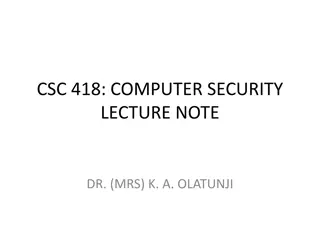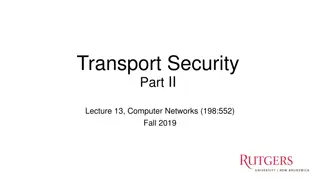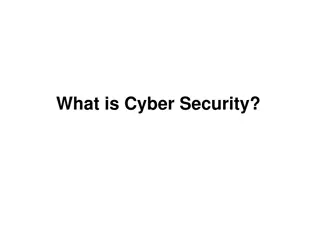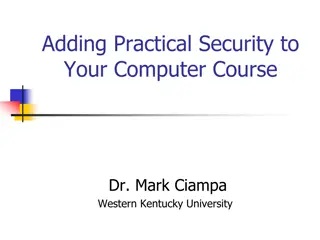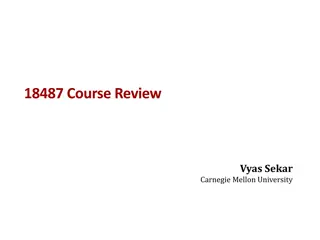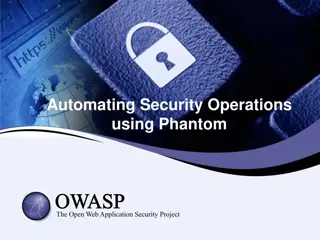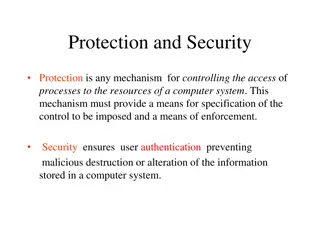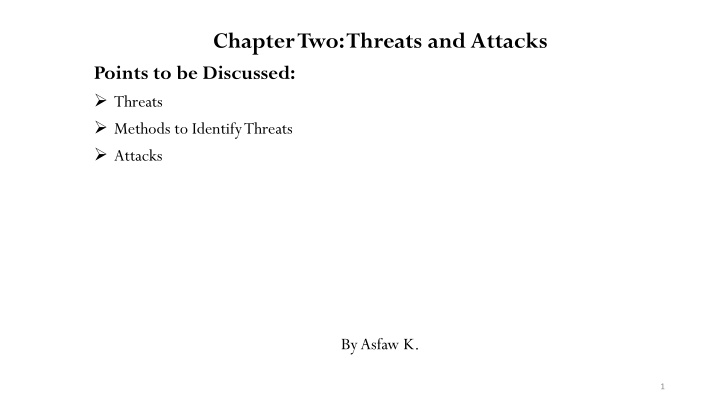
Threats and Attacks in Computer Security
Explore the concept of threats and attacks in computer security, including identifying threats, types of vulnerabilities, and countermeasures to protect valuable assets. Learn how to mitigate risks and safeguard systems from various potential dangers.
Download Presentation

Please find below an Image/Link to download the presentation.
The content on the website is provided AS IS for your information and personal use only. It may not be sold, licensed, or shared on other websites without obtaining consent from the author. If you encounter any issues during the download, it is possible that the publisher has removed the file from their server.
You are allowed to download the files provided on this website for personal or commercial use, subject to the condition that they are used lawfully. All files are the property of their respective owners.
The content on the website is provided AS IS for your information and personal use only. It may not be sold, licensed, or shared on other websites without obtaining consent from the author.
E N D
Presentation Transcript
Chapter Two: Threats and Attacks Points to be Discussed: Threats Methods to IdentifyThreats Attacks By Asfaw K. 1
Threats The goal of computer security is protecting valuable assets. To study different ways of protection, we use a framework that describes how assets may be harmed and how to counter or mitigate that harm. A potential for violation of security, which exists when there is a circumstance, capability, action, or event that could breach security and cause harm. That is, a threat is a possible danger that might exploit a vulnerability. A threat to a computing system is a set of circumstances that has the potential to cause loss or harm. Generic term for objects, people who pose potential danger to assets (via attacks) or an object, person, or other entity that represents a constant danger to an asset. Threat agent: Specific object, person who poses such a danger (by carrying out an attack). 2
Cont. There are many threats to a computer system, including human-initiated and computer- initiated ones. We have all experienced the results of inadvertent human errors, hardware design flaws, and software failures. But natural disasters are threats, too; they can bring a system down when the computer room is flooded or the data center collapses from an earthquake, for example. Vulnerability: Weakness or fault that can lead to an exposure. A human who exploits a vulnerability perpetrates an attack on the system. 3
Cont. We can consider potential harm to assets in two ways: First, we can look at what bad things can happen to assets, and second, we can look at who or what can cause or allow those bad things to happen. These two perspectives enable us to determine how to protect assets. One way to analyze harm is to consider the cause or source. We call a potential cause of harm a threat. Harm can be caused by either nonhuman events or humans. Examples of nonhuman threats include natural disasters like fires or floods; loss of electrical power; failure of a component such as a communications cable, processor chip, or disk drive; or attack by a wild boar. 4
Cont. Fig. 2.1 Kinds of Threats 5
Cont. Fig. 2.2 Threats to Information Security 6
How do we address these problems? We use a control or countermeasure as protection. That is, a control is an action, device, procedure, or technique that removes or reduces a vulnerability. A threat is blocked by control of a vulnerability. From the threat, we determine the vulnerabilities that could allow the threat to cause harm. Finally, we explore the countermeasures that can control the threat or neutralize the vulnerability. Thus, this is about protecting assets by countering threats that could exploit vulnerabilities. Before we can protect assets, we have to know the kinds of harm we have to protect them against, so now we explore threats to valuable assets. 7
Reconnaissance Reconnaissance definition states that it is a significant instrument as a starting point of numerous data hacking and for penetration testing. The cycle includes gathering data about the target machine that could be utilized to discover its blemishes, weaknesses, and security vulnerabilities. In the process of reconnaissance, hackers tend to be like detectives, gathering data, and information to comprehend their victims. From looking at email records to open source data, they wish to know about the organization better than the individuals who run and look after it. They focus on the security part of the innovation, study the shortcomings, and utilize any weakness for their potential benefit. 8
Attacks Act or action that exploits vulnerability (i.e., an identified weakness) in controlled system. Accomplished by threat agent which damages or steals organization s information. An attack can also be launched by another system, as when one system sends an overwhelming flood of messages to another, virtually shutting down the second system s ability to function. Unfortunately, we have seen this type of attack frequently, as denial-of-service attacks deluge servers with more messages than they can handle. Malicious code: launching viruses, worms, Trojan horses, and active Web scripts aiming to steal or destroy information. 9
Cont. Backdoor: accessing system or network using known or previously unknown mechanism Password crack: attempting to reverse calculate a password Brute force: trying every possible combination of options of a password Dictionary: selects specific accounts to attack and uses commonly used passwords (i.e., the dictionary) to guide guesses. 10
Cont. Denial-of-service (DoS): attacker sends large number of connection or information requests to a target: Target system cannot handle successfully along with other, legitimate service requests May result in system crash or inability to perform ordinary functions Distributed denial-of-service (DDoS): coordinated stream of requests is launched against target from many locations simultaneously. 11
Cont. Spoofing: technique used to gain unauthorized access; intruder assumes a trusted IP address 12
Cont. Spam: unsolicited commercial e-mail; more a nuisance than an attack, though is emerging as a vector for some attacks. Mail bombing: also a DoS; attacker routes large quantities of e-mail to target Sniffers: program or device that monitors data traveling over network; can be used both for legitimate purposes and for stealing information from a network Social engineering: using social skills to convince people to reveal access credentials or other valuable information to attacker. 13
Cont. Man-in-the-middle: attacker monitors network packets, modifies them, and inserts them back into network 14
Cont. Buffer overflow: application error where more data sent to a buffer than can be handled Timing attack: explores contents of a Web browser s cache to create malicious cookie Side-channel attacks: secretly observes computer screen contents/electromagnetic radiation, keystroke sounds, etc. 15
Cont. Fig. 2.3 Attack Replication Vectors 16
Parameters on Attacks Most computer security activity relates to malicious human-caused harm: A malicious attacker actually wants to cause harm, and so we often use the term attack for a malicious computer security event. 17
Cont. Malicious attacks can be random or directed. In a random attack the attacker wants to harm any computer or user; such an attack is analogous to accosting the next pedestrian who walks down the street. An example of a random attack is malicious code posted on a web site that could be visited by anybody. In a directed attack, the attacker intends harm to specific computers, perhaps at one organization (think of attacks against a political organization) or belonging to a specific individual (think of trying to drain a specific person s bank account, for example, by impersonation). 18
Cont. Another class of directed attack is against a particular product, such as any computer running a particular browser. (We do not want to split hairs about whether such an attack is directed at that one software product or random, against any user of that product; the point is not semantic perfection but protecting against the attacks.) The range of possible directed attacks is practically unlimited. 19
Group Assignment Review and Prepare Report on: Security Vulnerability, Attack and Risk Assessment on Saint Mary's University( other Offices) ICT Network and Information Security Should be submitted after one week of this class! 20











